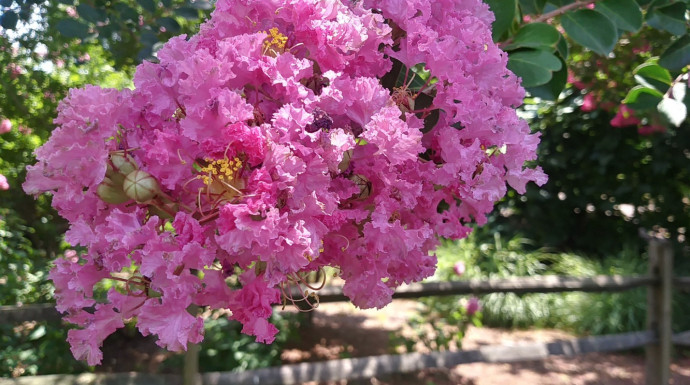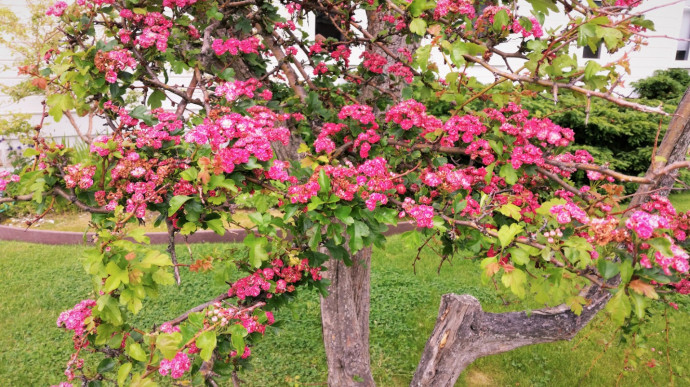|

1. Crape Myrtle (Lagerstroemia indica)
If you wish to follow up all of that spring color with terrific summer color, consider crape myrtle. A popular choice for Southerners, they have a long blooming period (mid-summer to fall) and grow 6 to 25 feet tall, with a multi-stem growth habit that can be trained into a tree form. The plant grows taller in warm southern ones. Northerners (to zone 5) can sometimes get away with treating these colorful specimens as shrubs that die back in winter but come back in spring.
Avoid excessive pruning, as it can kill the tree or cause suckers to emerge at the bottom of the tree.
2. Eastern Redbud

A small, multi-stemmed, pink flowering tree, eastern redbud can reach 20 to 30 feet tall with a rounded crown. Early spring flowers are breathtaking, opening from a reddish-purple in bud to a rosy pink bloom. The heart-shape leaves emerge after the flower and can turn a beautiful yellow in the fall. This fast grower is happiest in full sun or light shade with well-drained soil.
3. Star Magnolia

Star magnolia is one of the first plants to bloom in the spring, with white star-shape flowers that appear in March and April, before the leaves appear. This is a large shrub that grows to 15 to 20 feet, but it can be trained as a tree by pruning to retain a single stem to serve as the trunk. Star magnolia makes a great specimen tree in the yard, or it can be used in woodland borders. When grown as a shrub, it is sometimes used in tall informal hedges.
4. Flowering Dogwood

A spreading tree, flowering dogwood has horizontal branches that keep it looking beautiful even in the winter. Depending on your climate, the size can vary, but typically, dogwood is 20 to 40 feet tall and wide. Its leaves turn reddish-purple in the fall, and it produces glossy red fruit. The late-spring true flowers are tiny, but each one is surrounded by four eye-catching white or pink bracts. Care requirements can change depending on the variety, but in general, dogwoods like well-drained, slightly acidic soil. It is important to keep this tree in good condition, as stress can make it susceptible to several problems, the most problematic being dogwood anthracnose, a fungal disease. If caught early, removal of affected limbs may prevent it from spreading.
5. Forsythia

Usually an early sign of spring, forsythia is an upright, arching deciduous shrub with bright yellow flowers. Some branches arch, while others shoot upwards, giving it a lush, full appearance. Use in an informal hedge or as a specimen in a border. Easy-to-grow forsythia can handle plenty of different conditions, but it'll perform best in evenly moist, well-drained soil.
|

6. Oleander (Nerium oleander)
Oleander is a plant variously thought of as a small tree or tall shrub, reaching 20 feet in height. This small flowering tree is a broadleaf evergreen that produces white or deep pink blossoms. It blooms periodically through the season, though most heavily in May and June. These are poisonous plants, so be wary of planting them where children or pets can get at them. The toxicity, though, makes them immune to deer.
|

7. Weeping Cherry
Several varieties of weeping cherry trees are available, and they are among the most treasured plants of spring. Two of the most popular are:
Weeping higan (Prunus subhirtella 'Pendula'): 20 to 30 feet tall
Snow Fountains (Prunus 'Snofozam'): 8 to 15 feet tall
Weeping cherries need to be kept moist, especially in drought conditions. A 2-inch layer of mulch around the base of the tree can help with this.
Weeping cherries are typically planted individually as specimen trees, or in small groups.
|

8. Tree Hydrangea
This is one of the hardiest and latest-blooming hydrangeas. It has large, cone-shape white flowers in summer that gradually turn reddish-brown and last into winter. Although it can reach up to 15 feet tall, and be pruned as a tree, it's usually less than 10 feet tall. Slightly acidic, well-drained soil is best, and hydrangea trees can tolerate both full sun and part shade.
|

9. Rhododendron and Azalea
Both belonging to the genus Rhododendron, azaleas and rhododendrons share many characteristics. Both groups thrive in well-drained acidic soil and light shade. One point of difference is the shape of their flowers: Azaleas have funnel-shape blossoms, while rhododendrons have trumpet-shape flowers. And although there are literally hundreds of species and varieties in the Rhododendron family, the most popular are planted for their brilliance and the high number of spring flowers they produce.
|

10. Saucer Magnolias (Magnolia x soulangiana)
The various kinds of saucer magnolia are often bigger, growing to 20 to 30 feet, than star magnolia and have bigger flowers. They also often bloom a bit later but they are worth the wait, especially if you prefer pinkish flowers to white. The name "saucer" is meant to describe the large size of the blossoms. Avoid planting this tree in southern exposures, as the flower buds may emerge too early and be prone to cold damage. This plant is sometimes grown as a large shrub in borders, or used as a specimen tree. It needs a protected location to prevent spring cold from damaging the flowers.











